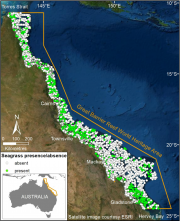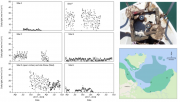NESP TWQ Round 3 - Project 3.2.1 - Deriving ecologically relevant load targets to meet desired ecosystem condition for the Great Barrier Reef: a case study for seagrass meadows in the Burdekin region
This project will derive ecologically relevant targets (ERTs) for water quality and sediment loads by: 1) defining seagrass desired state targets; 2) calculating water quality guidelines (light); and 3) calculating ERTs for terrestrially sourced sediment loads. Historical and new data collections will be used to derive ERTs via statistical models and eReefs (RECOM), and the seagrass sub-model in eReefs will be used to test ERTs. A framework for setting seagrass desired state will be developed for the entire GBR and water quality guidelines and sediment load ERTs will be quantitatively defined for the Burdekin basin where suspended sediments affect seagrass condition.
NESP TWQ 3.2.1 Reports, Factsheets and Articles on NESP TWQ Hub Website.
Images
Datasets

This project will derive ecologically relevant targets (ERTs) for water quality and sediment loads by: 1) defining seagrass desired state targets; 2) calculating water quality guidelines (light); and 3) calculating ERTs for terrestrially sourced sediment loads. Historical and new data collections will be used to derive ERTs via statistical models and eReefs (RECOM), and the seagrass sub-model in eReefs will be used to test ERTs.

This dataset summarises 35 years of seagrass data collection (1984-2018) within the Great Barrier Reef World Heritage Area into one GIS shapefile containing seagrass presence and absence survey data for 81,387 sites.

This dataset summarises daily integrals of photosynthetically active radiation (PAR) at six sites in Cleveland Bay from March 2017 to October 2018. PAR was measured every 15 minutes (as µmol m-2 s-1), and converted to daily light integrals (mol m-2 d-1).





